Sampling Volatiles From Fragranced Consumer Products Using High-Capacity Sorptive Extraction
This study describes the analysis of fragranced washing detergent and washing powder using probe-based headspace and immersive sorptive extraction, in conjunction with analysis by thermal desorption–gas chromatography–mass spectrometry (TD–GC–MS). As well as discussing the differences between the two samples, the analyte ranges covered by headspace and immersive sampling are compared.
Photo Credit: RRA79/Shuttestock.com

Lara Kelly and David Barden, Markes International, Llantrisant, UK
This study describes the analysis of fragranced washing detergent and washing powder using probe-based headspace and immersive sorptive extraction, in conjunction with analysis by thermal desorption–gas chromatography–mass spectrometry (TD–GC–MS). As well as discussing the differences between the two samples, the analyte ranges covered by headspace and immersive sampling are compared.
The success of many personal care and household cleaning products has long depended on the precise mix of aromaâactive compounds that they release. For example, manufacturers are continuously developing new formulations that offer different (or longer-lasting) fragrances, while consumers loyal to a well-established brand can notice even the slightest variation in fragrance quality. In addition, there has been increasing concern over the presence of potentially harmful compounds-such as allergens-in fragrance formulations. These factors have led to an ongoing need to monitor the volatile and semivolatile organic compounds (VOCs and SVOCs) released by fragranced consumer products.
Sampling and analyzing VOCs and SVOCs from a wide range of products and materials has long been performed using gas chromatography (GC), enhanced by preconcentration using thermal desorption (TD). TD provides a versatile and highâsensitivity alternative to traditional sample preparation methods for GC, such as solvent extraction, solidâphase microâextraction (SPME), or static headspace, and involves minimal manual sample handling while being applicable to the widest possible range of GC-compatible analytes. In the field of consumer products, TD has generally been associated with sampling vapours released from solid samples, but recent developments in sorptive extraction have extended the applicability of TD preconcentration technology to aqueous samples (1).
This study aims to demonstrate the use of headspace and immersive sorptive extraction probes for the analysis of VOCs and SVOCs in a liquid washing detergent and washing powder solution.
Experimental
Samples: Two fragranced household products were analyzed: (1) liquid washing detergent; (2) washing powder solution (prepared by dissolving 1 g of powder in 18.5 mL water).
Headspace Sorptive Extraction: Sample: 10 mL sample in 20 mL headspace vial, sealed with a HiSorb septum seal and cap. Sampler: Short-length, inert HiSorb-P1 probe (Markes International part no. H1-AXABC-5). TD tube: Empty (Markes International part no. C0-AXXX-0000). Sample incubation: HiSorb Agitator (Markes International). Sampling temp.: 40 °C. Agitation speed: 300 rpm. Sampling time: 90 min.
Immersive Sorptive Extraction: Sample: 18.5 mL sample in 20 mL headspace vial, sealed with a HiSorb septum seal and cap. Sampler: Standardâlength, inert HiSorb-P1 probe (Markes International part no. H1âAXAAC-5). Other conditions as for headspace sorptive extraction.
TD: Instrument: TD100-xr (Markes International). Cold trap: Tenax TA (Markes International part no. U-T9TNX-2S). Desorption time: 10 min. Desorption temp.: 280 °C. Trap low temp.: 25 °C. Heating rate: Max. Trap high temp.: 290 °C. Trap hold time: 1.5 min. Outlet split: 100 mL/min. Split ratio: 51:1. Flow path temp.: 180 °C.
GC: Column: 60 m × 0.32 mm, 1.8-µm VFâ624ms (Agilent Corporation). Oven: 40 °C (3 min), then 6 °C/min to 230 °C (15 min). Inlet: 180 °C. Carrier gas: Helium, 2.0 mL/min. Septum purge: 3.0 mL/min. MS transfer line: 240 °C.
MS: Ion source: 230 °C. Quadrupole: 150 °C. Mass range: m/z 35–450.
Data Analysis: TargetView GC–MS software (Markes International) was used to selectively remove unwanted background noise from the chromatograms, carry out automated comparison against a 407-component fragrance-compound target library, and generate peak-area information.
Results and Discussion
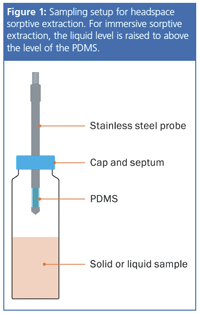
Sampler Design and Operation: The highâcapacity sorptive extraction probes used in this study consist of a short section of poly(dimethylsiloxane) (PDMS) located at the end of a stainless-steel probe, which is either immersed in the sample or suspended above it (Figure 1). Agitation and gentle heating is then sufficient to ensure that analytes are effectively absorbed into the sorbent volume in a reasonable time frame. A key consideration is the relatively large sorbent volume (65 μL compared to 0.5 μL for SPME), which, combined with GC preconcentration by TD, results in higher sample loadings and therefore greater sensitivity across a wide analyte range.
Comparison of Overall Fragrance Profiles: The fragrance profiles of the washing detergent and washing powder (using both sampling techniques) are shown in Figures 2 and 3, respectively, with major components being labelled and listed in Table 1. It is reasonable to expect that the washing detergent would be more heavily fragranced than the washing powder, and indeed this is apparent from the chromatogram, which shows a more complex profile. However, only n-hexyl acetate (#6), dihydromyrcenol (#10), linalool (#12), and β-citronellol (#15) are present at substantial levels in both samples.
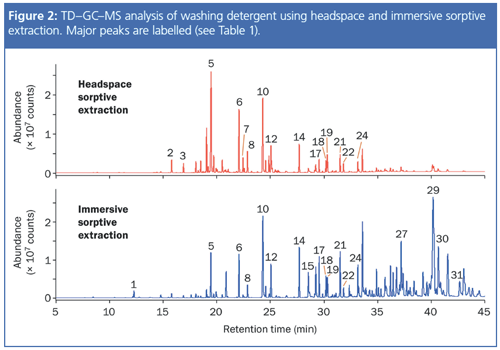
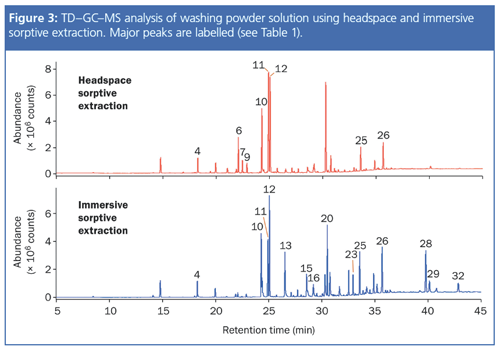
Comparison of Immersive Sorptive Extraction with Headspace Sorptive Extraction: For both samples, although there remains a considerable degree of overlap in analyte range between the headspace and immersive approaches, it is clear that the immersive approach is better at sampling the less volatile compounds. As a result, many of the later eluting compounds identified using immersive sorptive extraction are not fragrance compounds-but they are nevertheless important constituents of the formulation that may have an effect on the overall product quality. Immersive sorptive extraction therefore provides a useful complement to the headspace techniques by allowing a more comprehensive understanding of the compounds present to be obtained. For example, it is interesting that although amyl salicylate (#27) is presumably added to the washing detergent formulation in substantial quantity (because of its significant presence in the immersive profile), it is nearly absent from the headspace profile.
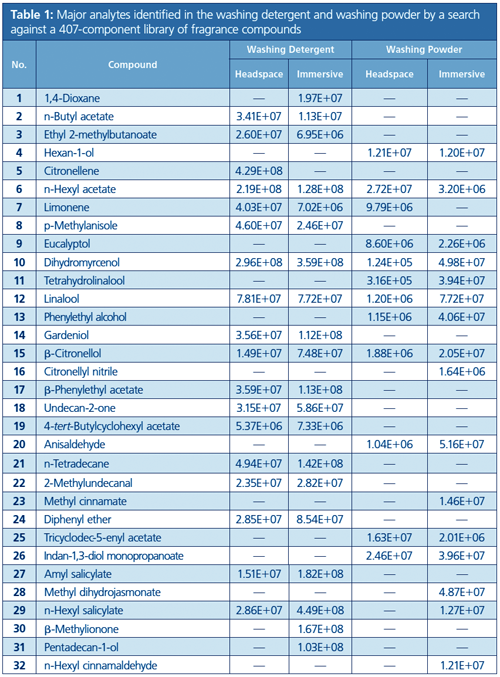
Conclusions
In this study, we have shown that highâcapacity sorptive extraction can be used in conjunction with TD–GC–MS analysis to provide valuable information on the volatile profiles of fragranced consumer products.
A key benefit of this approach is versatility, with the same approach being compatible with both headspace and immersive sampling of liquids or solids. The immersive approach, while sampling the vast majority of analytes found in the headspace, preferentially samples the less volatile compounds, therefore delivering a more comprehensive profile including compounds that would not typically contribute to the fragrance. As well as being robust and easy to handle, the probes avoid the interference effect that can occur with SPME when liquid rising up into the SPME fibre casing remains there during the next sampling run, which can result in poor reproducibility.
These factors make this approach highly suitable for analyzing a range of sample types-not just fragranced consumer products, but also foods, beverages, and biological samples. Potential applications include routine quality control, product comparison, troubleshooting customer complaints, product development, and advanced research-a diverse range of uses that reflects the versatility of this technology.
Reference
- For examples, see Markes International Application Notes 120 (milk), 122 (filter coffee), 123 (herbal infusions), 124 (alcoholic spirits), and 125 (premium teas), available at http://chem.markes.com/l/129721/2016-10-31/24vx7m
Lara Kelly is Sales Development Manager at Markes, having joined the company in 2002. Lara studied chemical and analytical science at the University of Wales, Swansea, UK, before receiving a Ph.D. in physical chemistry from the same institution in 2004. In her current role she is involved with the development of thermal desorption products and applications involving the use of sorptive extraction.
David Barden is Technical Copywriter at Markes, having joined the company in 2011. David studied natural sciences at the University of Cambridge, UK, and remained there for his Ph.D. in synthetic organic chemistry, which he received in 2003. A placement at WileyâVCH, Germany, was then followed by seven years as a journals editor at Royal Society of Chemistry Publishing, UK.
E-mail:enquiries@markes.comWebsite: www.markes.com
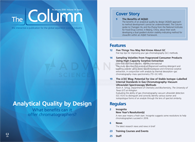
New Study Reviews Chromatography Methods for Flavonoid Analysis
April 21st 2025Flavonoids are widely used metabolites that carry out various functions in different industries, such as food and cosmetics. Detecting, separating, and quantifying them in fruit species can be a complicated process.
University of Rouen-Normandy Scientists Explore Eco-Friendly Sampling Approach for GC-HRMS
April 17th 2025Root exudates—substances secreted by living plant roots—are challenging to sample, as they are typically extracted using artificial devices and can vary widely in both quantity and composition across plant species.
Sorbonne Researchers Develop Miniaturized GC Detector for VOC Analysis
April 16th 2025A team of scientists from the Paris university developed and optimized MAVERIC, a miniaturized and autonomous gas chromatography (GC) system coupled to a nano-gravimetric detector (NGD) based on a NEMS (nano-electromechanical-system) resonator.

.png&w=3840&q=75)

.png&w=3840&q=75)



.png&w=3840&q=75)



.png&w=3840&q=75)












